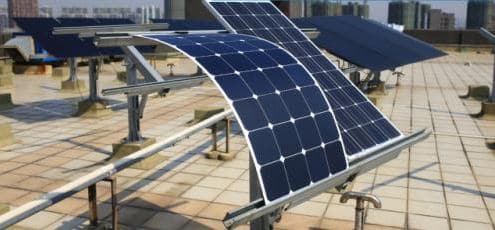Nowadays, there are different ways to produce energy. We can produce energy at homes, and when we think of installing solar panels, we usually see their costs, aesthetics, and efficiency. There are some factors which we look for while thinking of installing a solar panel. These factors will affect the solar panel you choose. You also need to consider how the solar panel will look on your roof and its installation charge and manufacturing costs for a solar panel.
There are various types of solar panels available in the market, and each one has its pros and cons. So you need to choose carefully, and your choice depends on the guide of the solar panel, which we will be discussing here. All types of solar panels function differently in different situations. It is essential to choose the right type of solar panel for your roof and choose a solar panel that fits best in your budget.
Contents
What Are Solar Panels?

Solar panels are devices that absorb the sunlight and convert them into electrical or heat energy. The solar cells are arranged in a grid-like structure on the surface of the solar panels. They can also be called the set of the photovoltaic module. These panels are tough when it comes to wear and tear and are known for their effectiveness. Most of the solar panels use crystalline silicon cells.
Types of solar panels:
- Monocrystalline
- Polycrystalline
- Thin film
Each of these solar panels has a unique type of solar cells in them, and all have different aesthetic appearances.
Monocrystalline Solar Panel

This one is the oldest type of solar panel, and it is the most developed one. They manufacture solar panels from about 40 monocrystalline cells made from pure silicon. Its manufacturing process is called the Czochralski method, and in this method, they place the silicon crystals in a vat of molten silicon. Then slowly, they are pulled out from the vat to allow the molten silicon to form a solid and hard crystal shell surrounding it, called an ingot. The ingot is sliced into thin pieces to make silicon wafers. Once they mold the wafers into cells, they assemble them to form a solar panel. They usually appear black as the rays of the sun interact with pure silicon. Due to their black color, they have varieties of colors and designs for black frames and sheets. The monocrystalline are square-shaped with no corners, so they have gaps in between them.
Polycrystalline Solar Panel

Polycrystalline are newly developed solar panels, and they are rising in popularity due to their efficient way of working. They are also made with silicon cells, just like the monocrystalline. However, the polycrystalline cells are formed by the silicon crystal pieces, which are melted together. They are manufactured by placing the silicon crystal in the vat of molten silicon, and instead of pulling it slowly, they break it into pieces and then cool it down. Once they are cooled down, the fragmented crystals are sliced into thin polycrystalline wafers and are collected to form the polycrystalline solar panel.
They have a blue color because of the reflection of the sunlight on the crystals. Sunlight differently reflects the blue color than it reflects the pure silicon cells. There can be variation, but often the black frames and sheets are silver with polycrystalline. They are square in shape, and there are no gaps between the corners of the cell.
Thin-film Solar Panels

These solar panels are the most developed than the previous two, and they are famous in the solar panel industry. The feature which makes them unique is that they are not made from silicon. They are made using various types of material such as amorphous silicon, copper indium gallium, cadmium telluride, and selenide. They make these cells by placing the main material in the middle of the thin sheets of conductive material, and a glass layer is placed on top of them to protect them. The amorphous panels use silicon, but they use non-crystalline silicon, and they are also covered with glass.
The thin solar panels are easy to recognize by their thin appearance, and they are approximately 350 times thinner than silicon wafers. But sometimes, they can be large and can appear like monocrystalline and polycrystalline solar panels. They are black and blue, depending on the material.
Despite their manufacturing and appearances, some factors make them different in their performance. The main factors are efficiency and the cost of the solar panels.
Efficiency

Efficiency is how much energy a solar panel produces from sunlight. Initially, the efficiency is determined by the power of the solar panel. The most efficient solar panel is the monocrystalline solar panel. A monocrystalline solar panel can reach up to 20% of the efficiency. At the same time, the polycrystalline solar panel uses only about 15% of the efficiency. This log between the two panels can affect future technology and improve the efficiency of polycrystalline solar panels. The least efficient panel is the thin-film panel as it produces less power at approximately 11%. The thin-film panel can vary in power capacity because of its size, and some models can produce more power than others.
Cost

Cost is one of the most important decisions to make when considering buying a solar panel. The solar cells affect the price of the solar panel. The most affordable solar panels are the thin-film solar panels as they have low-cost manufacturing. The CIGS are the ones that are the most expensive, and the CdTe are the cheaper ones in the market. The lighter ones are usually the thin-film. Therefore they can save your installation cost. The monocrystalline are the most expensive ones, as their manufacturing cost and the frames are expensive. Polycrystalline are the ones that are developed to lower the cost of the solar panels, and they are less expensive than monocrystalline. The gap between the monocrystalline and the polycrystalline can be filled as the manufacturers find efficient ways to create monocrystalline solar cells.
Conclusion
Installing a solar panel can help you overcome the harmful emissions of greenhouse gases and reduce global warming. The solar panels do not cause any pollution or harm to the environment. They help to decrease the dependencies on fossil fuels and other power sources. You can use these solar panels on a wide range of equipment like calculators that work in the sunlight. Choose the solar panel which is best suited to your budget and live freely without harming the environment.


